-
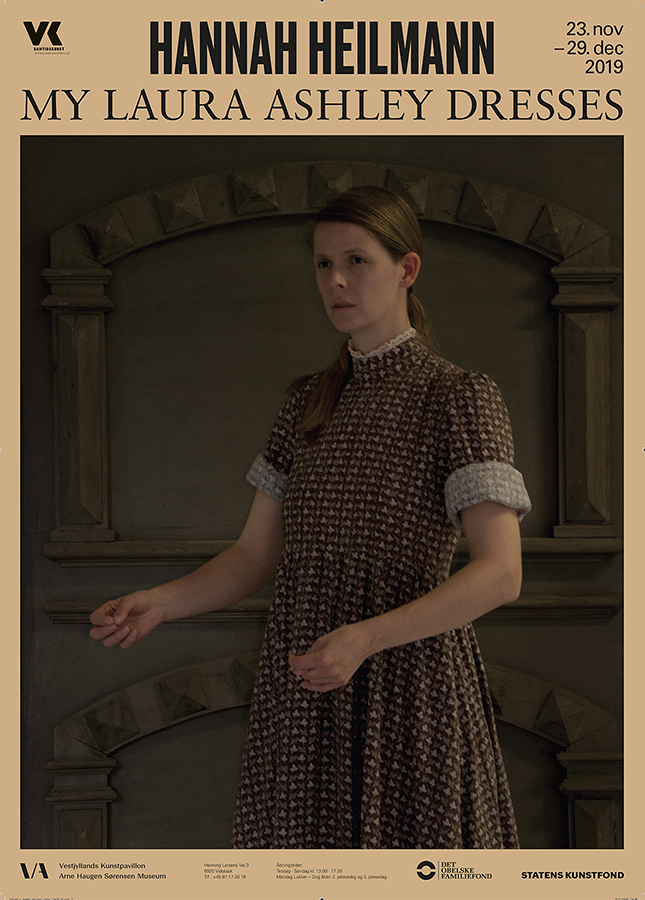
Photo for poster: Sigrun Gudbrandsdottir
-
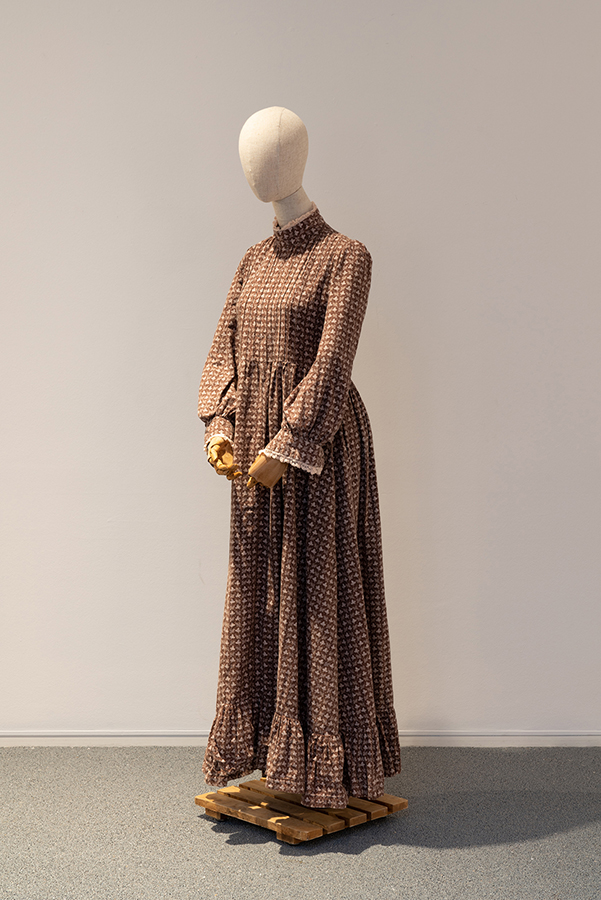
MY LAURA ASHLEY DRESSES, 2012-19. My collection of 1970s and 80s Laura Ashley dresses, presented on Chinese dress mannequins with linen look and wooden arms, painted chair from back home. Photo: David Stjernholm.
-
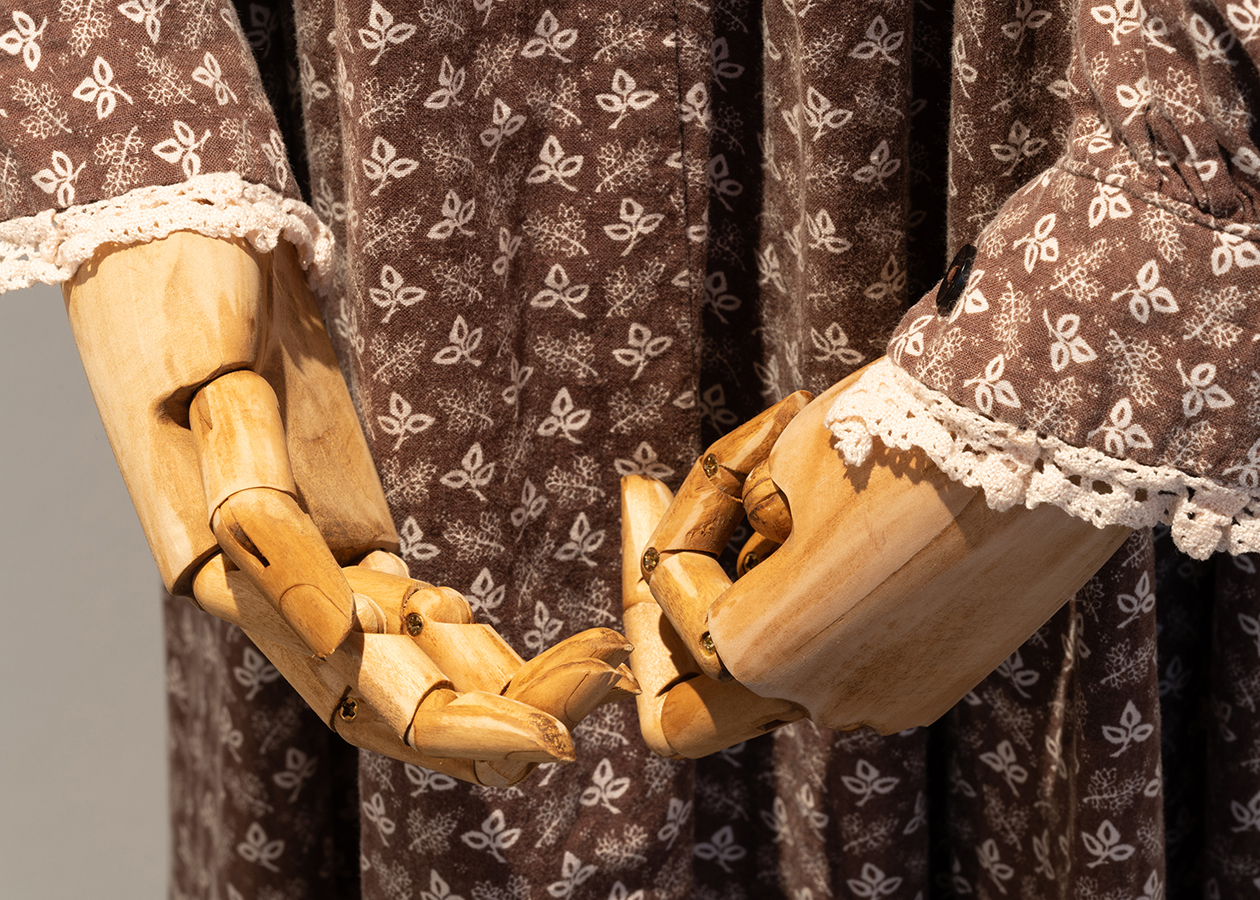
Photo: David Stjernholm.
-
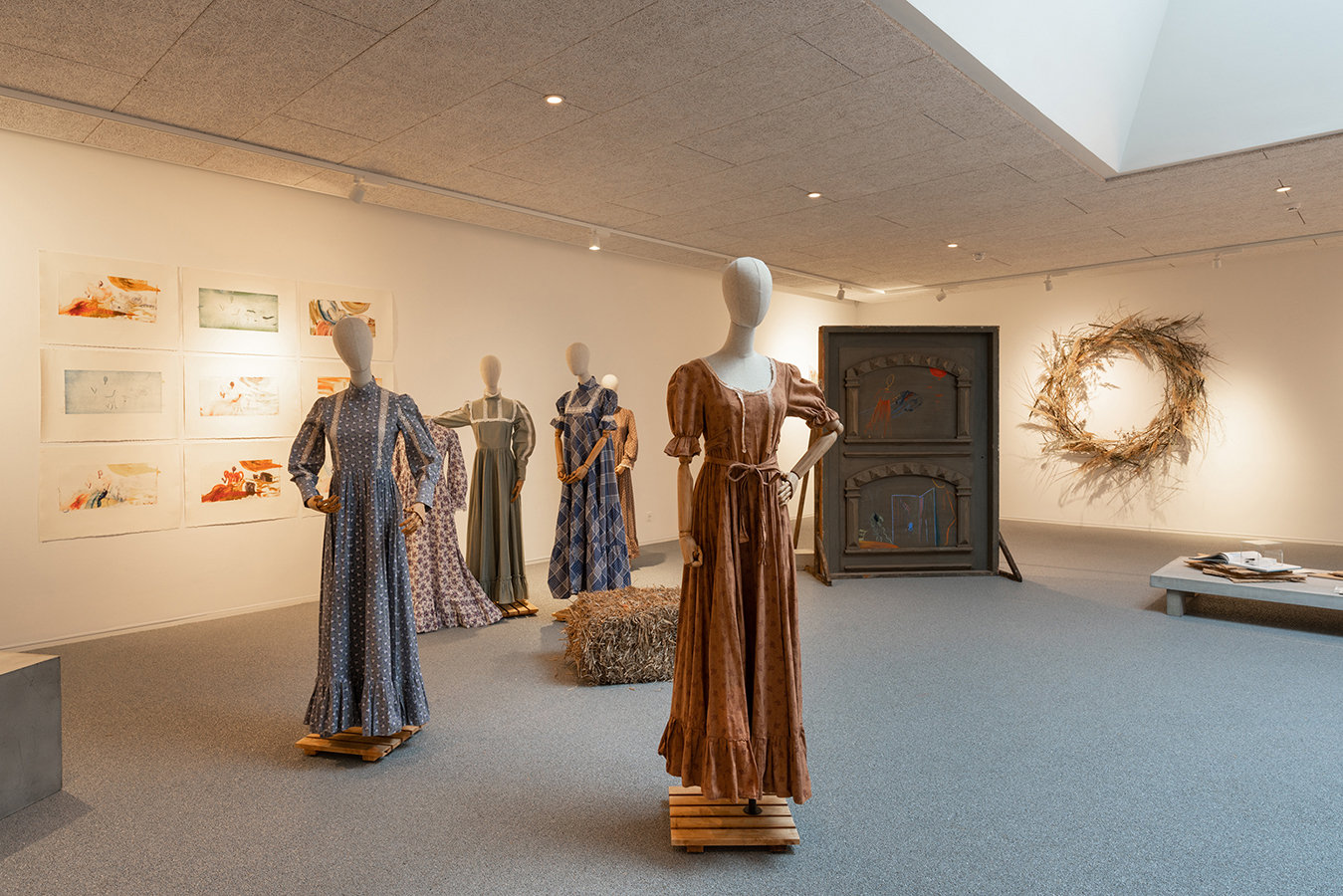
MY LAURA ASHLEY DRESSES (installation view). Photo: David Stjernholm.
-
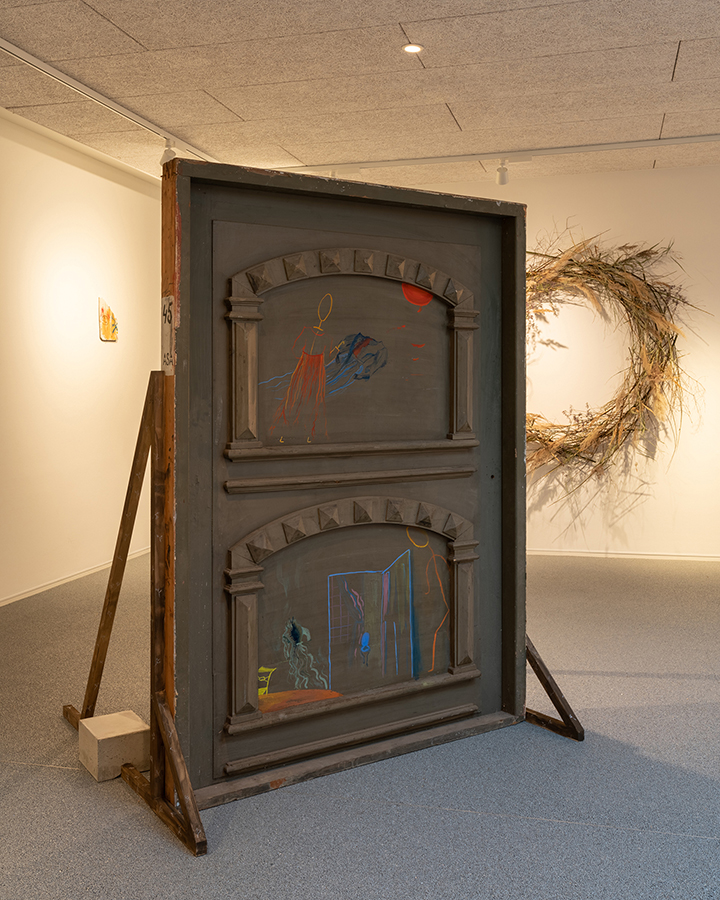
ASSAULT SCENES, 2019. Casein paint on found film scenography door and wood, concrete. HARVEST HYMN, 2019. Monumentally sized wreath of willow and grasses commissioned at the local flower shop. Photo: David Stjernholm.
-
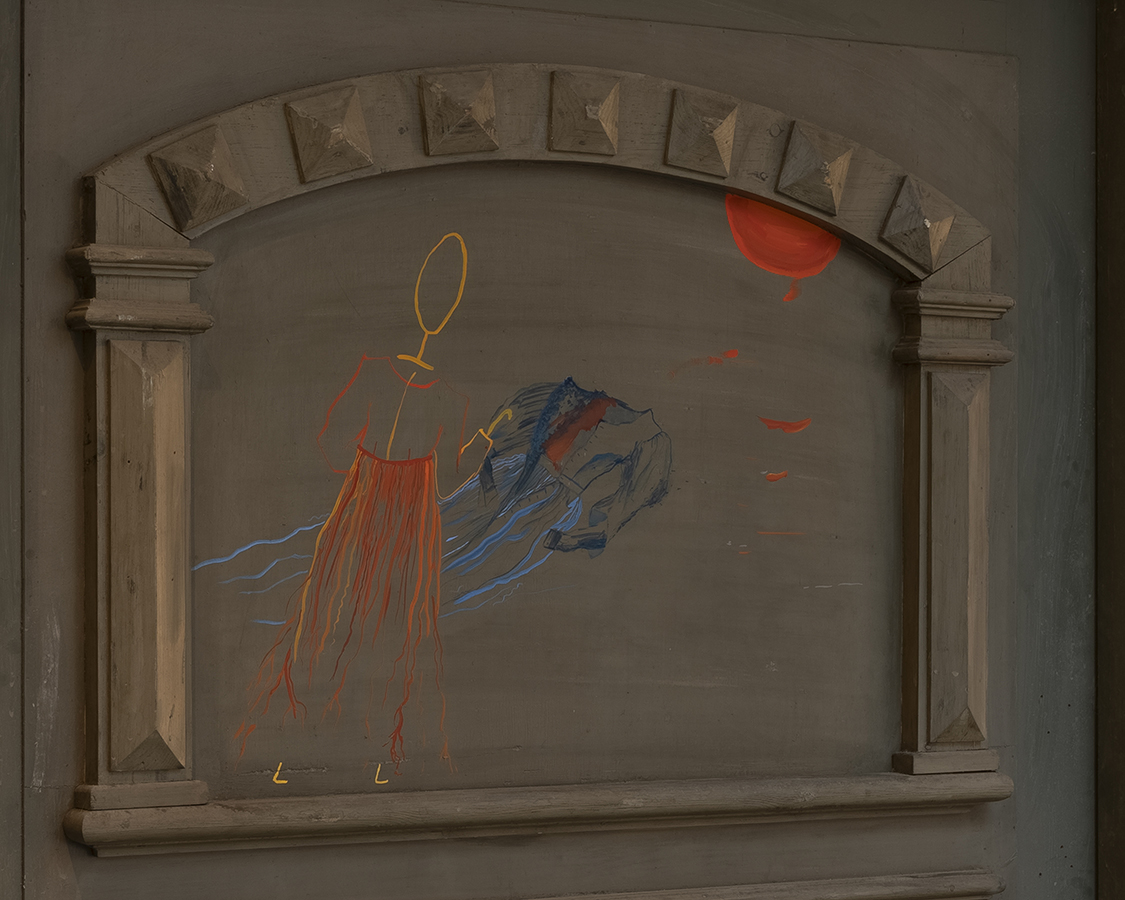
ASSAULT SCENES, 2019 (close up). Casein paint on found film scenography door and wood, concrete. Photo: David Stjernholm.
-
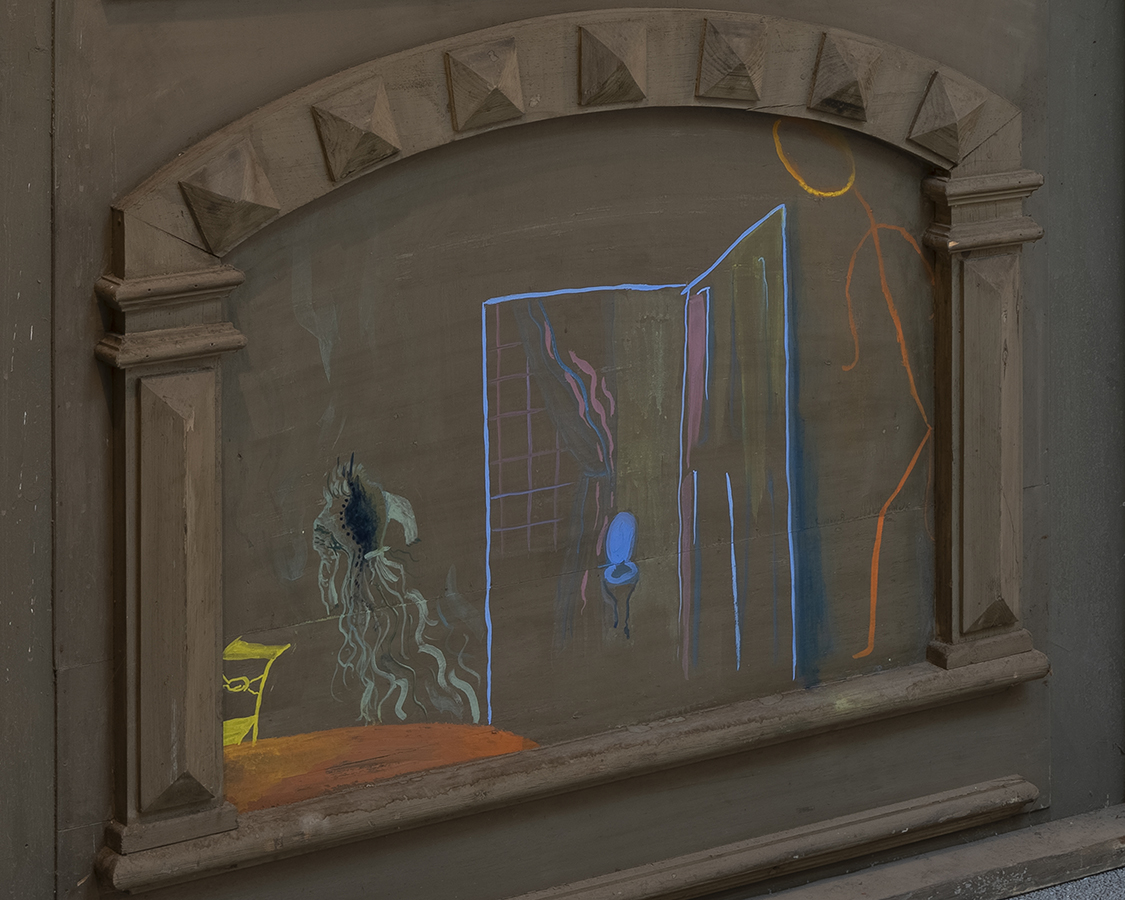
ASSAULT SCENES, 2019 (close up). Casein paint on found film scenography door and wood, concrete. Photo: David Stjernholm.
-
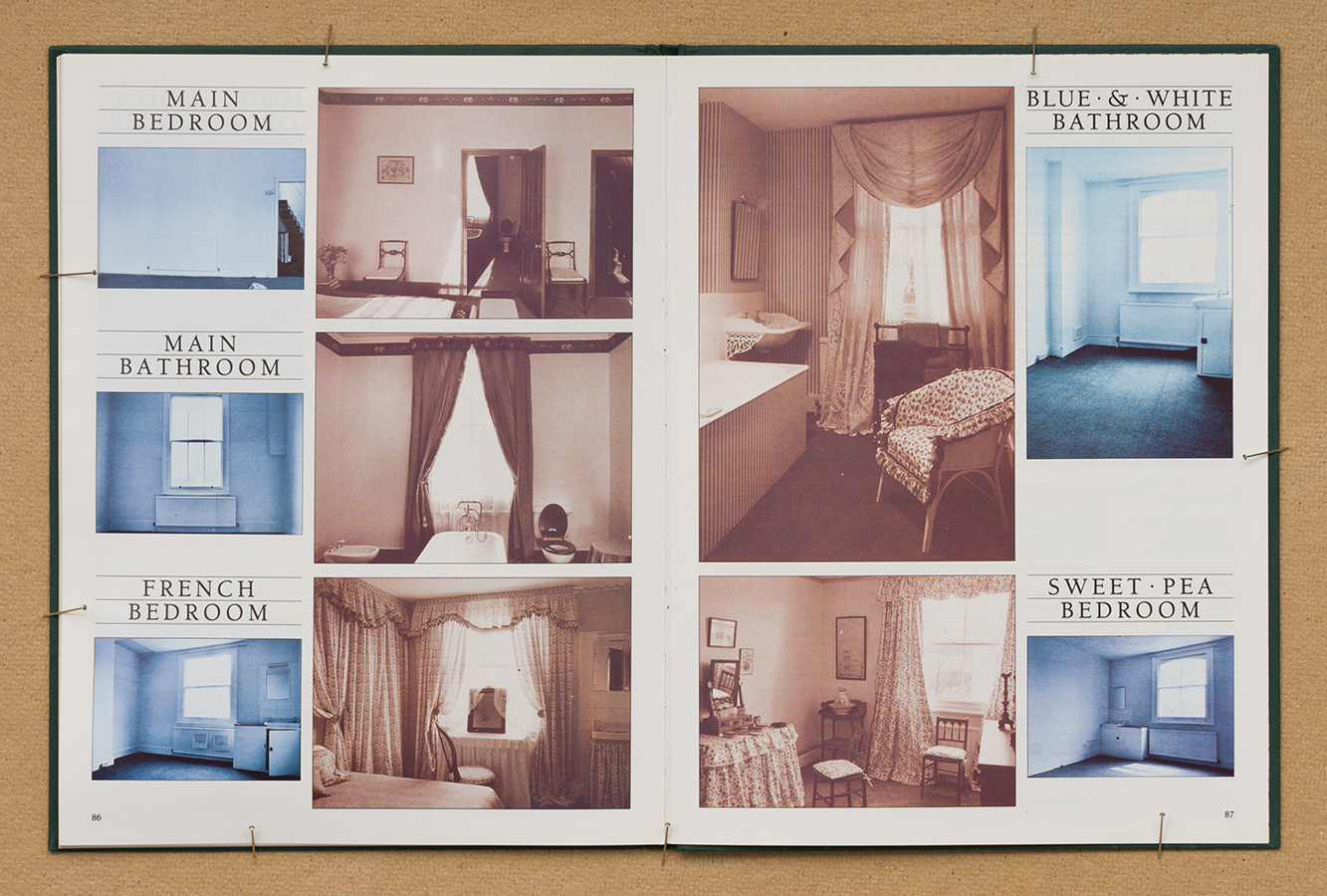
AT THE END OF THE DAY NOTE BOARDS, 2019 (close up of Jane Clifford, Laura Ashley decorates a London House, Studio Press Limited 1985 on porous wood fiber plate). Photo: David Stjernholm.
-
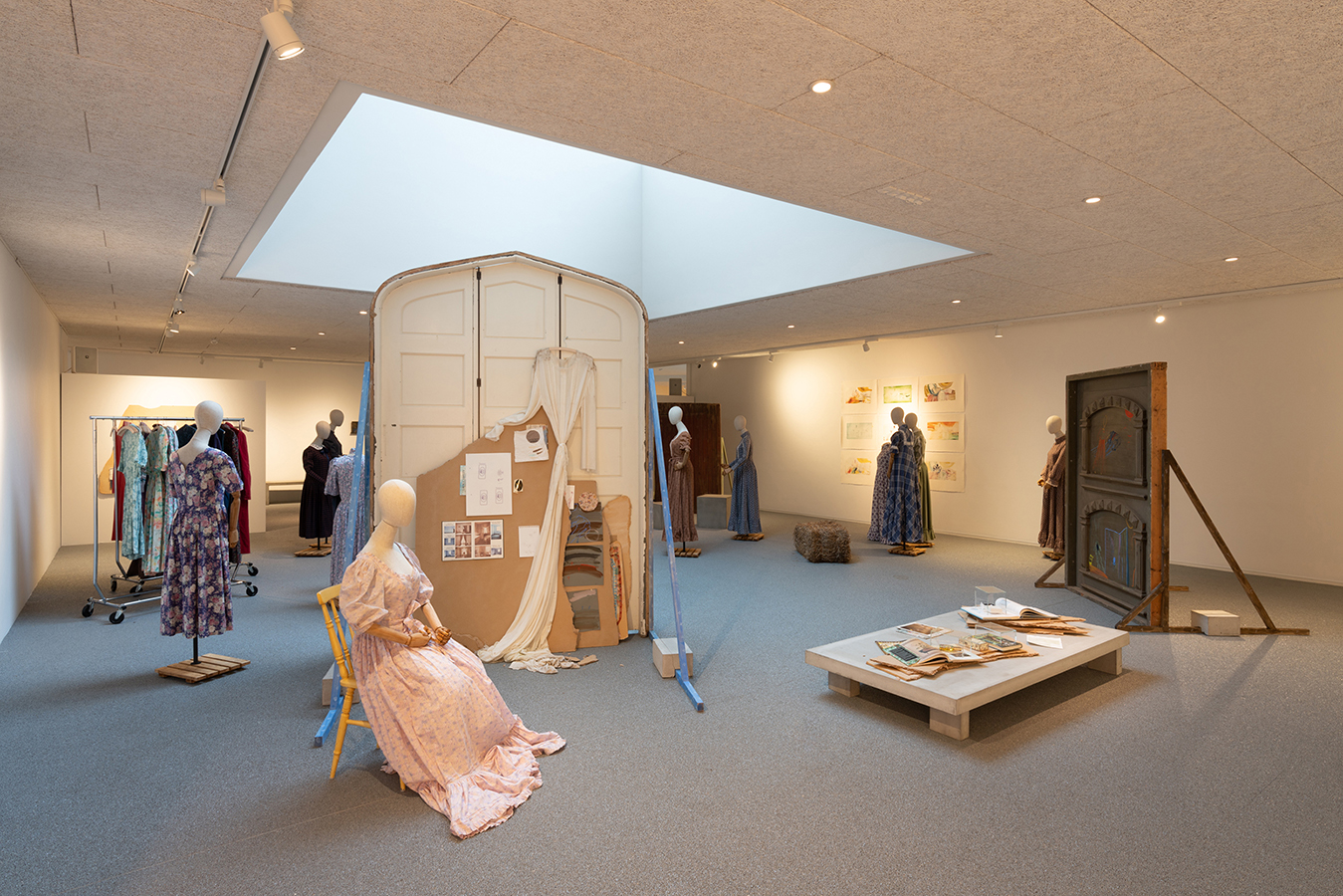
AT THE END OF THE DAY NOTE BOARDS, 2019 (back side of Small flowered and big flowered). Porous wood fiber plates, sunset rag of discarded clothes, Laura Ashley sewing pattern (McCall’s Carefree Patterns from 1970’s size 14), riso print, Jane Clifford, Laura Ashley decorates a London House, Studio Press Limited 1985 cover and book, Bugge Blomster sticker, pencil sketch, jam jar fabric sun, casein paint on grey paper, sewing pattern, gift ribbons and trims, pins.MILKY MOM, 2018.
Heroine sized dressbased on Laura Ashley sewing pattern x 1,5, jersey in milk protein- and wood fibers (casein and modal), weathered in wood. Photo: David Stjernholm. -
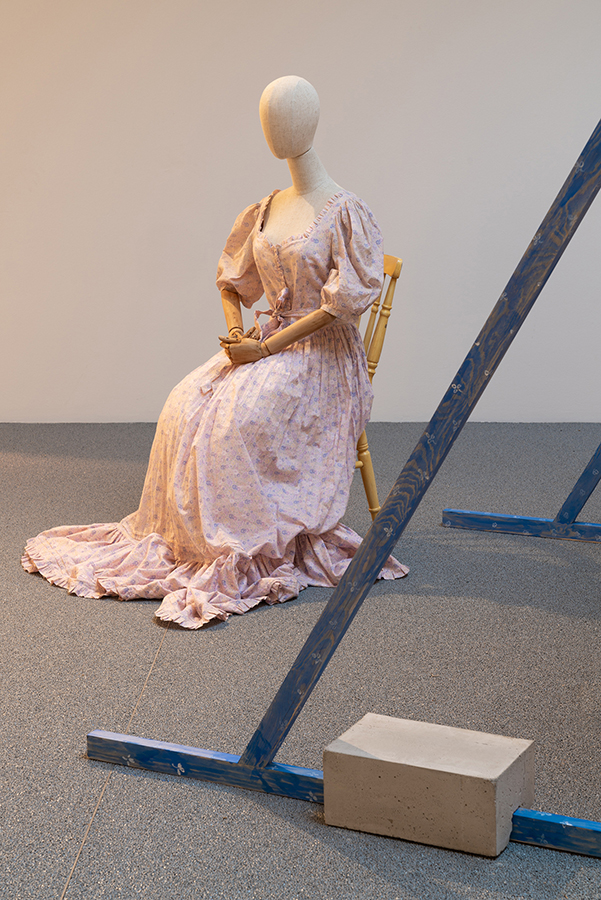
MY LAURA ASHLEY DRESSES (installation view). Photo: David Stjernholm.
-
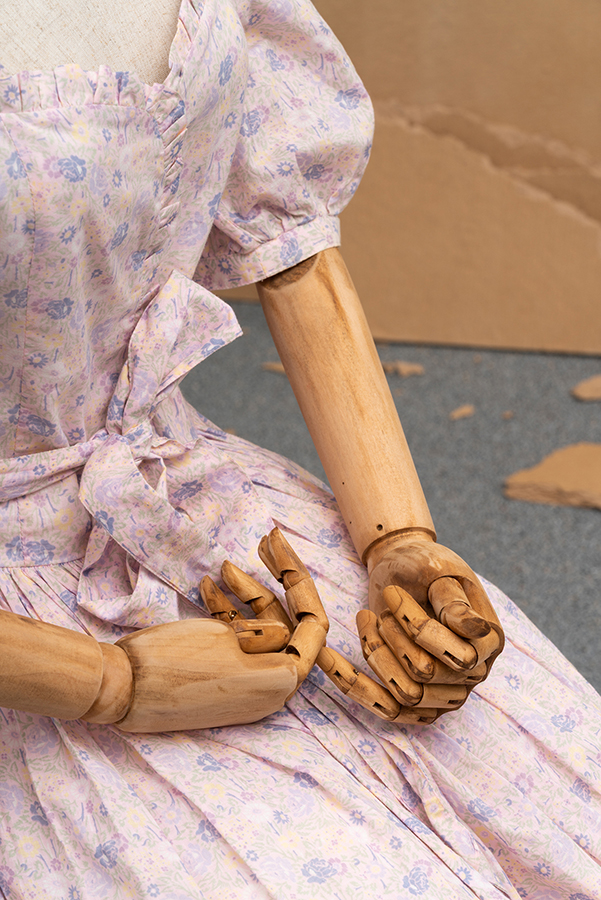
MY LAURA ASHLEY DRESSES (installation view). Photo: David Stjernholm.
-
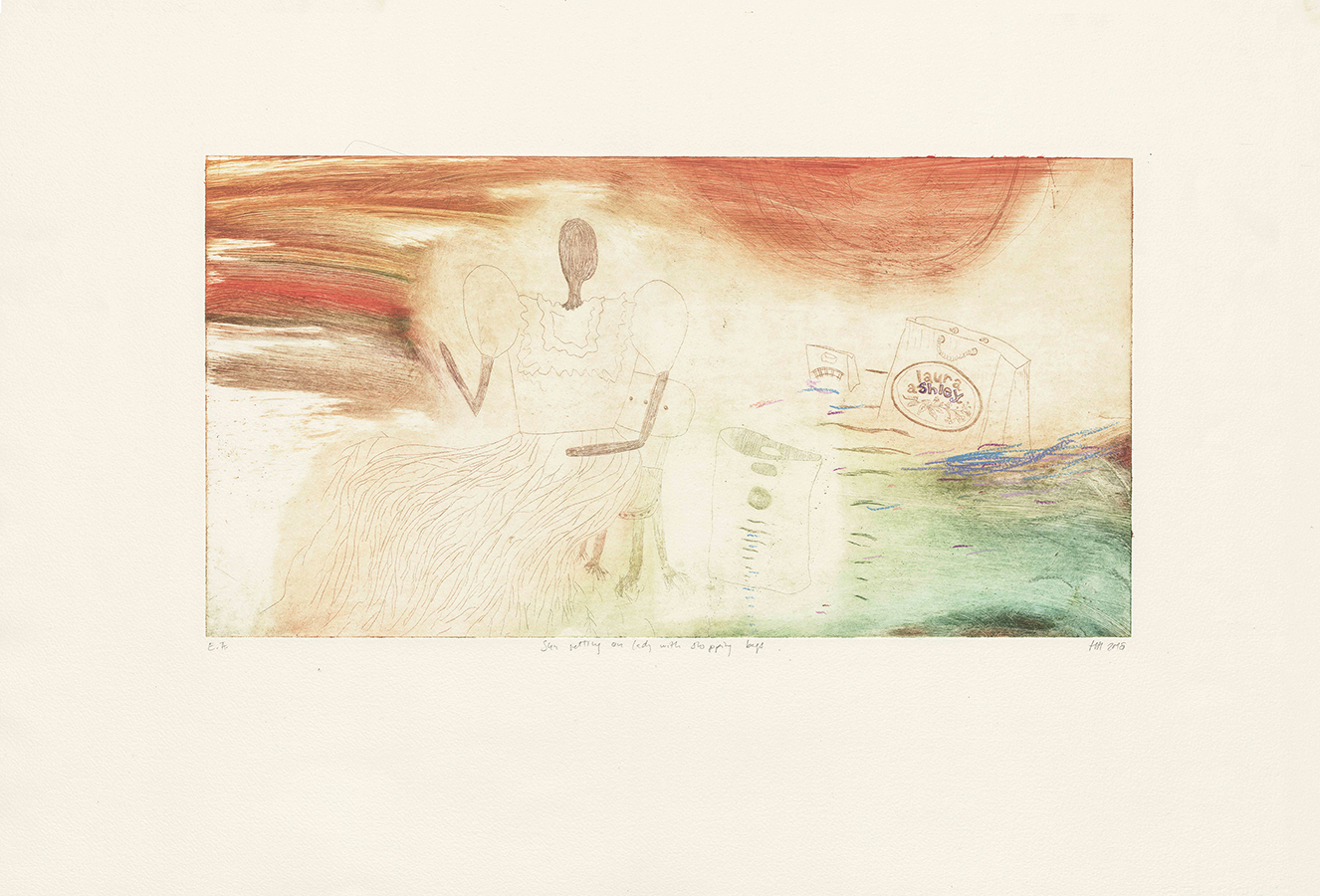
SUN SETTING ON LADY WITH SHOPPING BAGS (shopaholics edition), 2018/19 (close up). 9 etchings/monotypes with ink and pen details.
-
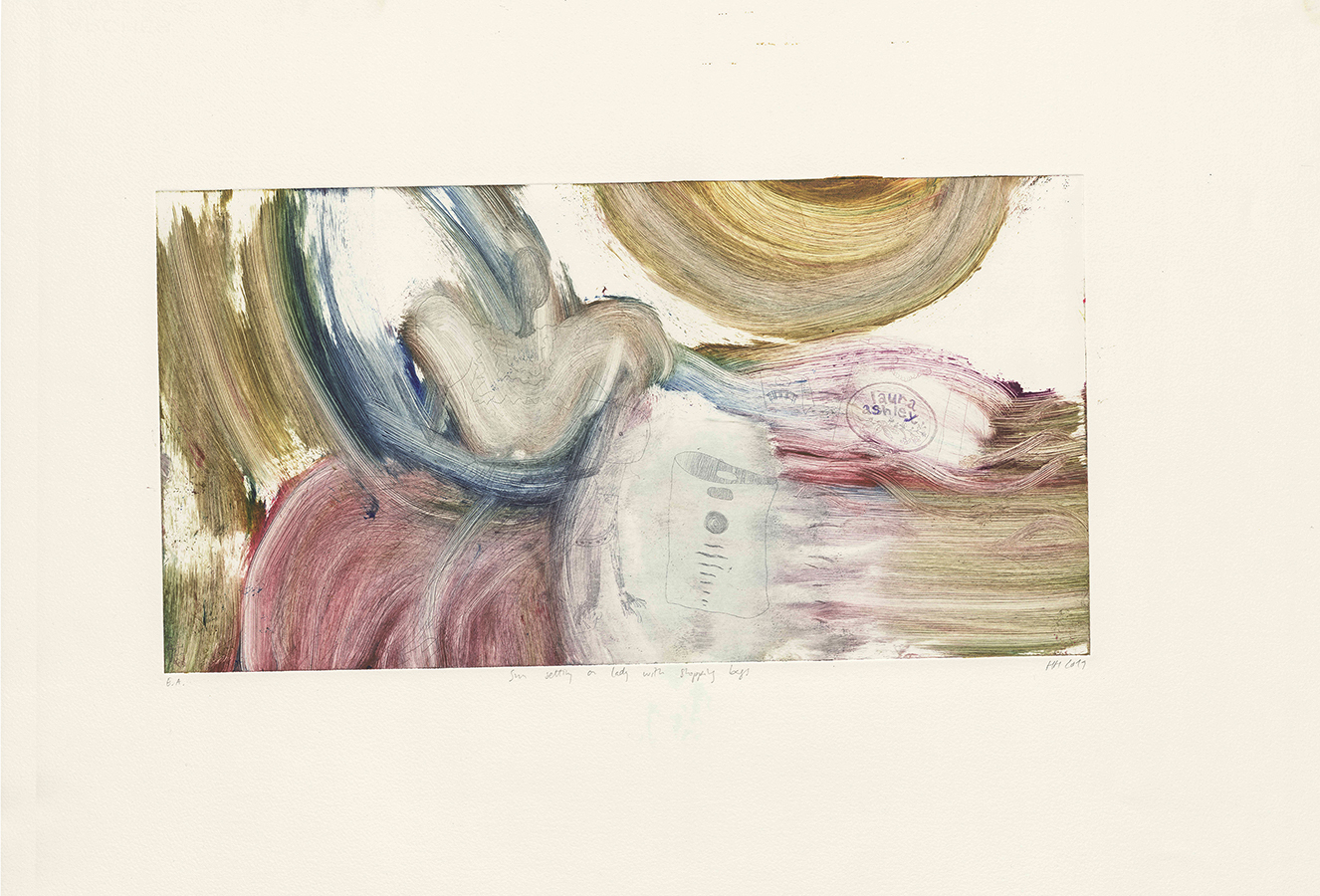
SUN SETTING ON LADY WITH SHOPPING BAGS (shopaholics edition), 2018/19 (close up). 9 etchings/monotypes with ink and pen details.
-
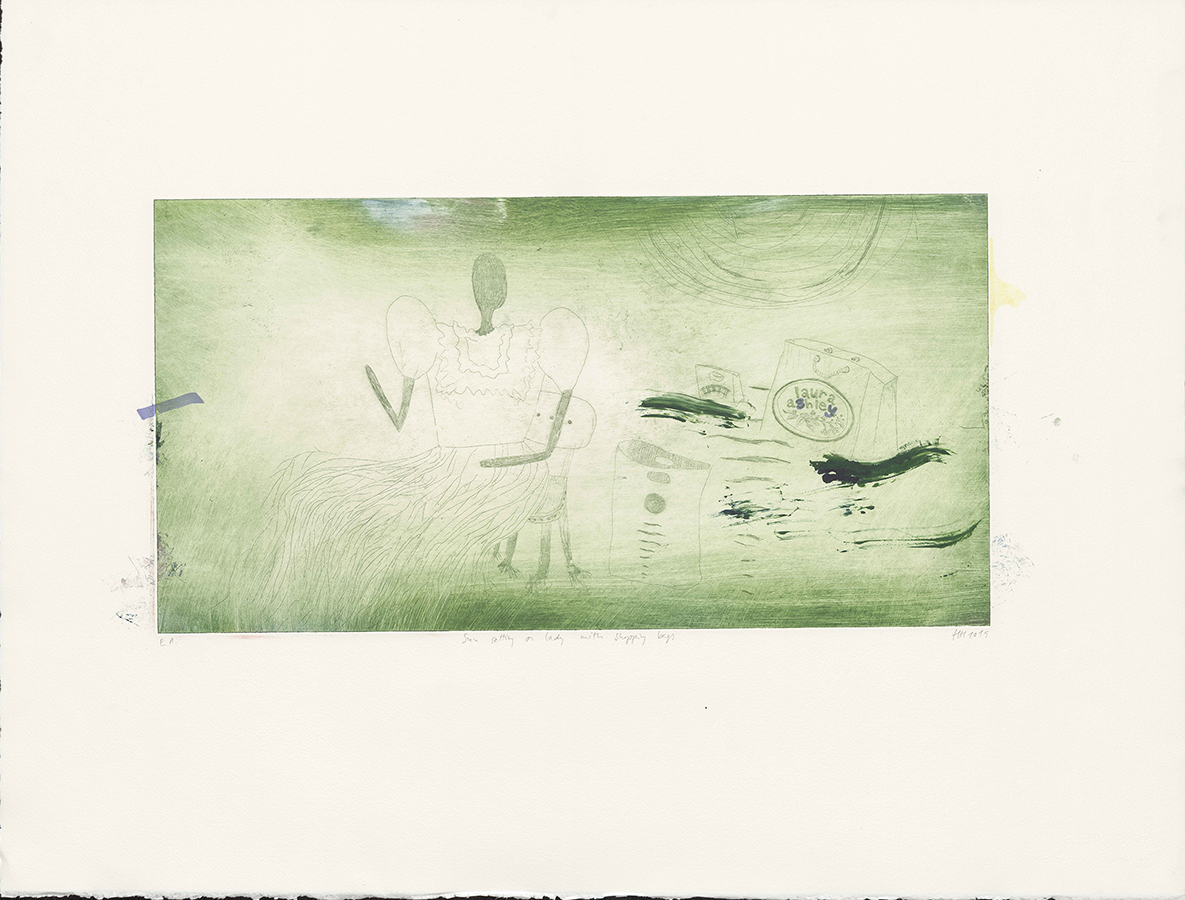
SUN SETTING ON LADY WITH SHOPPING BAGS (shopaholics edition), 2018/19 (close up). 9 etchings/monotypes with ink and pen details.
-
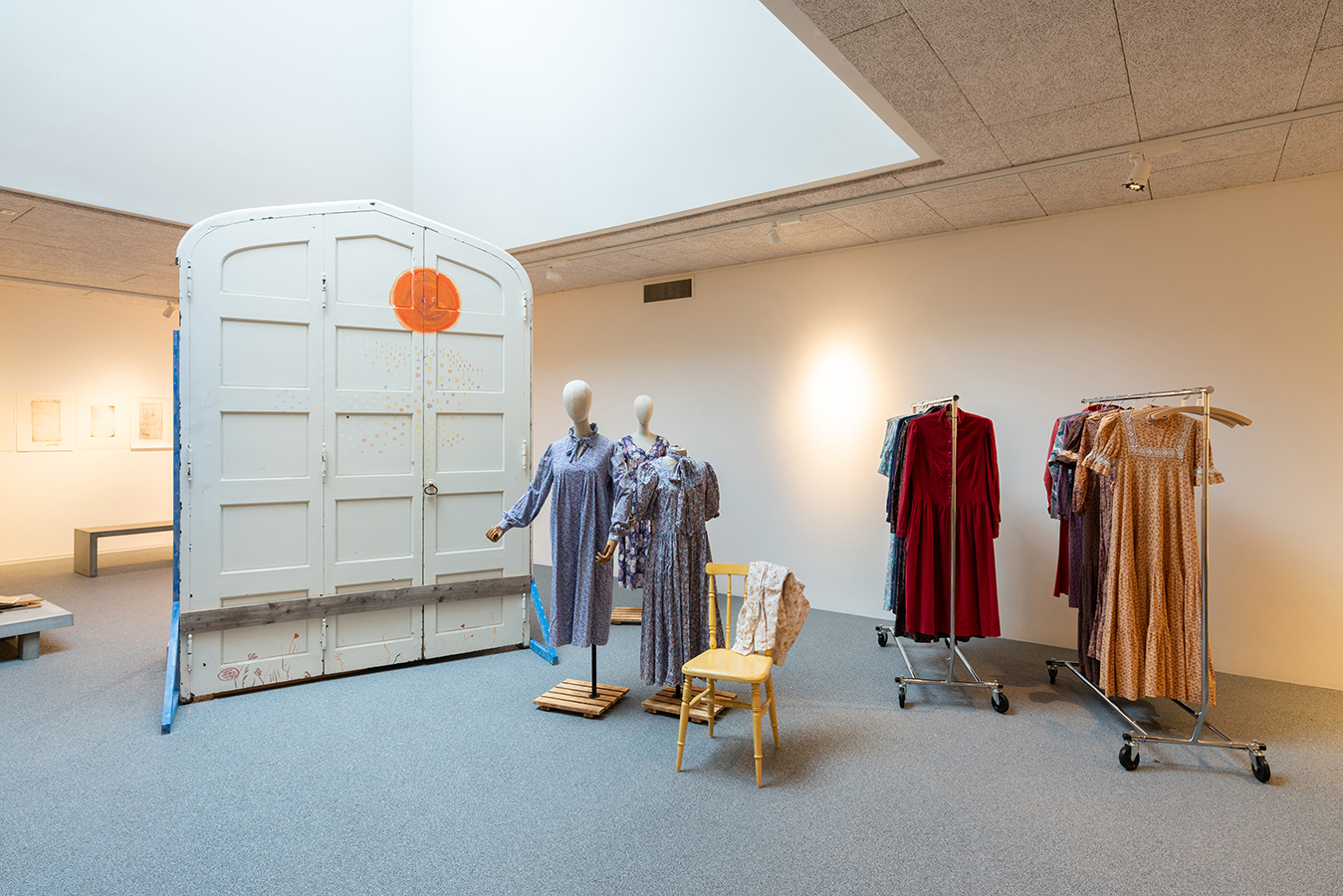
SMALL FLOWERED AND BIG FLOWERED, 2019. Casein paint on found church door, casein and acrylics on wood, concrete. Photo: David Stjernholm.
-
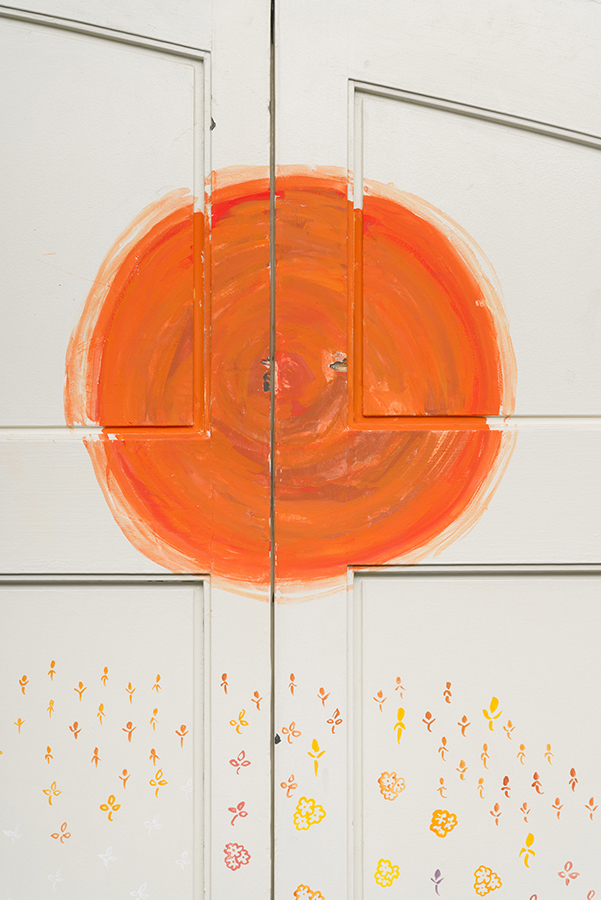
SMALL FLOWERED AND BIG FLOWERED, 2019 (close up). Casein paint on found church door, casein and acrylics on wood, concrete. Photo: David Stjernholm.
-
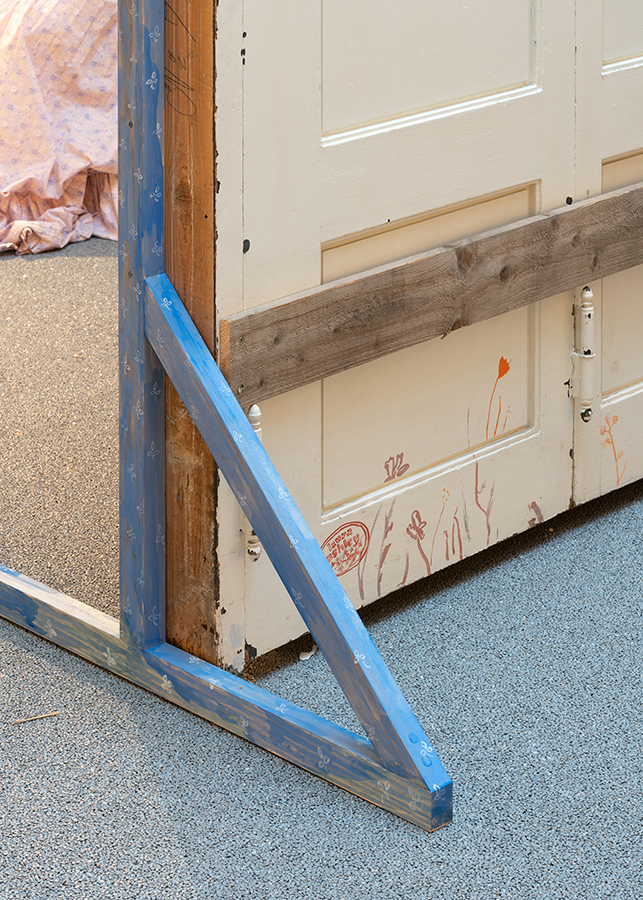
SMALL FLOWERED AND BIG FLOWERED, 2019 (close up). Casein paint on found church door, casein and acrylics on wood, concrete. Photo: David Stjernholm.
-
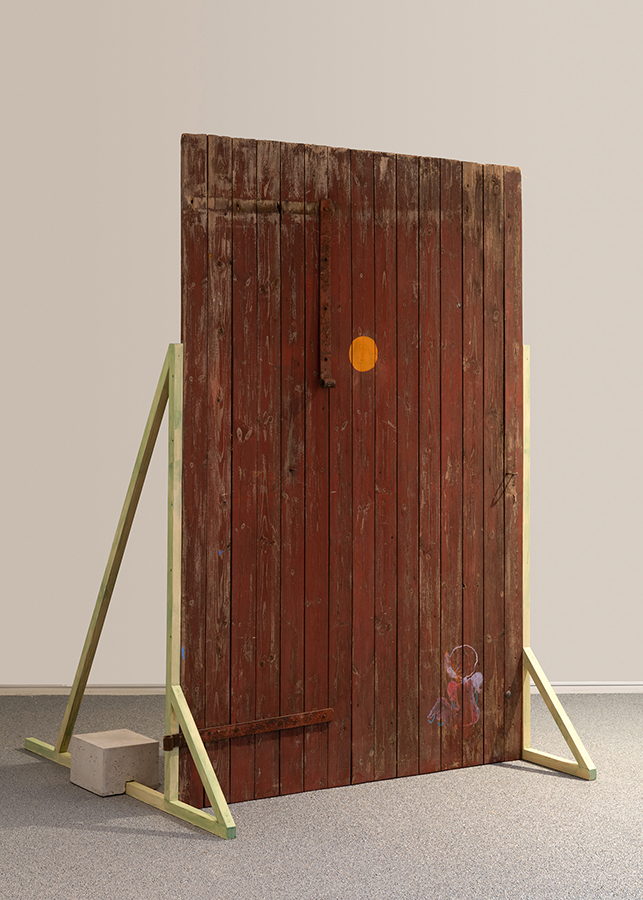
TEMPESTA, 2019. Casein painting on found door, wood, concrete. Photo: David Stjernholm.
-
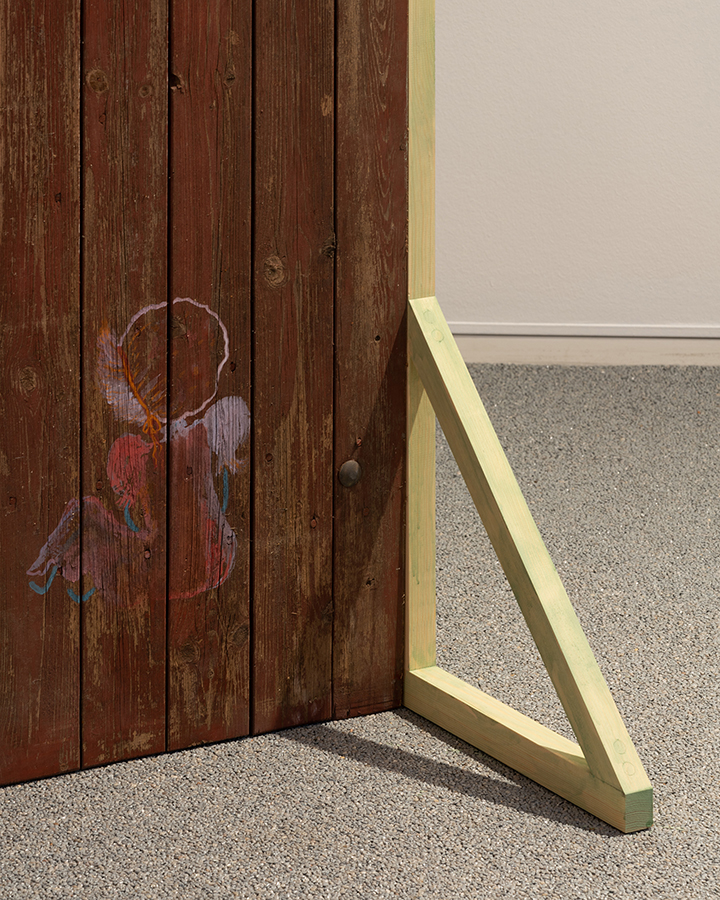
TEMPESTA, 2019 (close up). Casein painting on found door, wood, concrete. Photo: David Stjernholm.
-
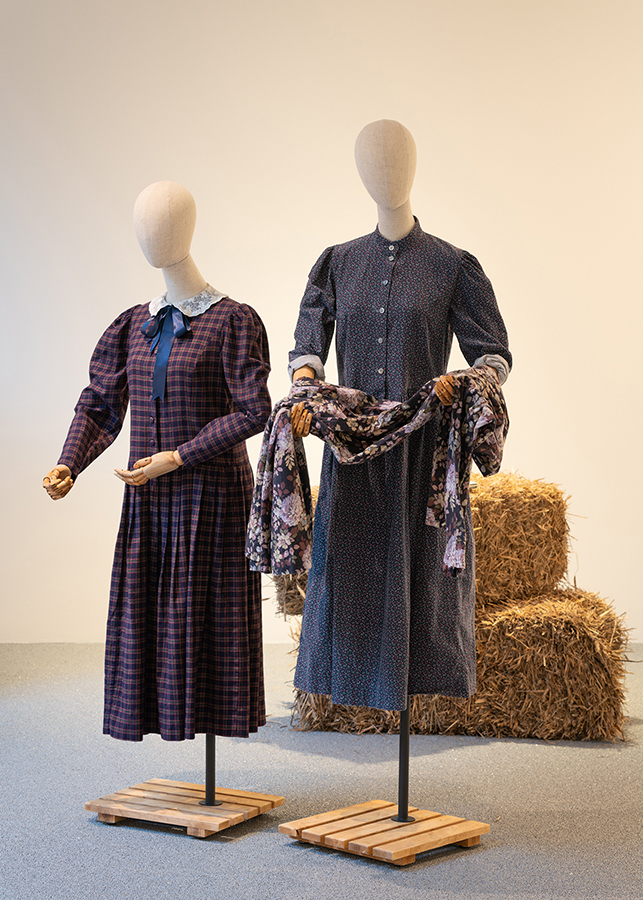
MY LAURA ASHLEY DRESSES, 2012-19. My collection of 1970s and 80s Laura Ashley dresses, presented on Chinese dress mannequins with linen look and wooden arms and supports. Photo: David Stjernholm.
-
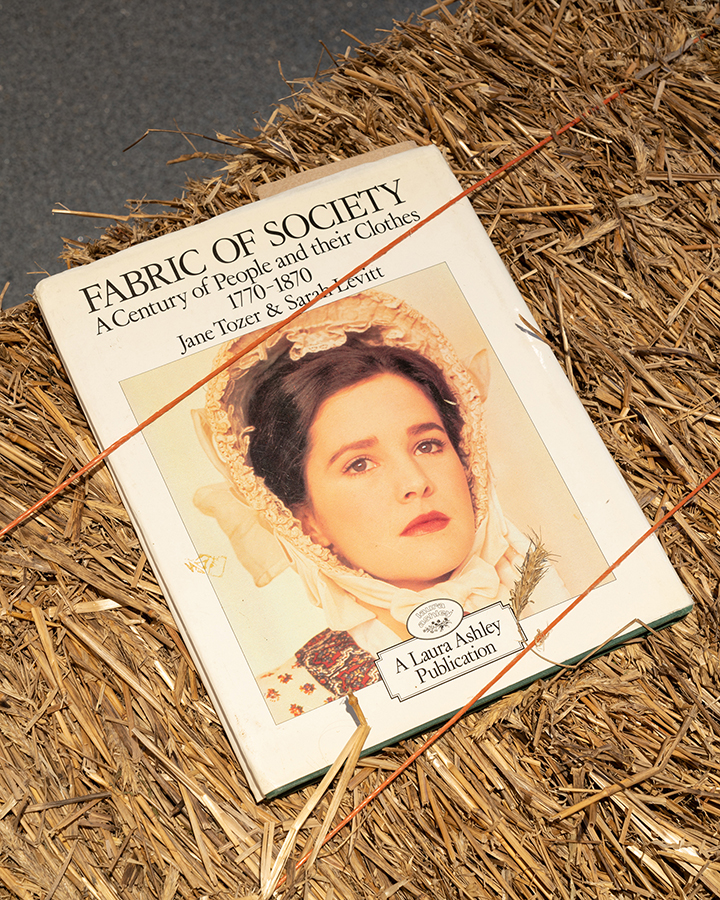
THE WORLD OF LAURA ASHLEY, 2019. Close up of Jane Tozer & Sarah Levitt, Fabric of society: A century of people and their clothes 1770-1870, Laura Ashley Publication 1983, rye straw bales (Morten Korch-type) lended by farmer in Husby. Photo: David Stjernholm.
-
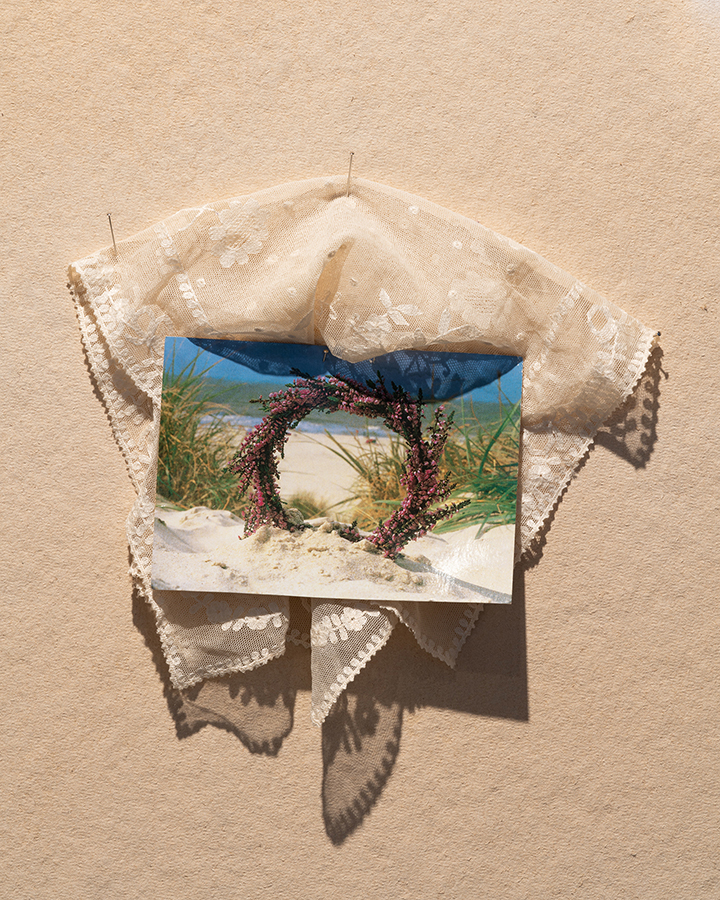
NOTES, 2019 (close up). Acrylics on porous wood fiber plate, order summery for Chinese dress mannequins, acrylics on plastic bag, Laura Ashley sewing pattern, lace, postcard, c-print on printer paper of family photos (my sister and the first set of clothes I sewed my self, and one from the time when I moved temporarily to my moms place and brought so many clothes and put them in her attic without asking). Photo: David Stjernholm.
-
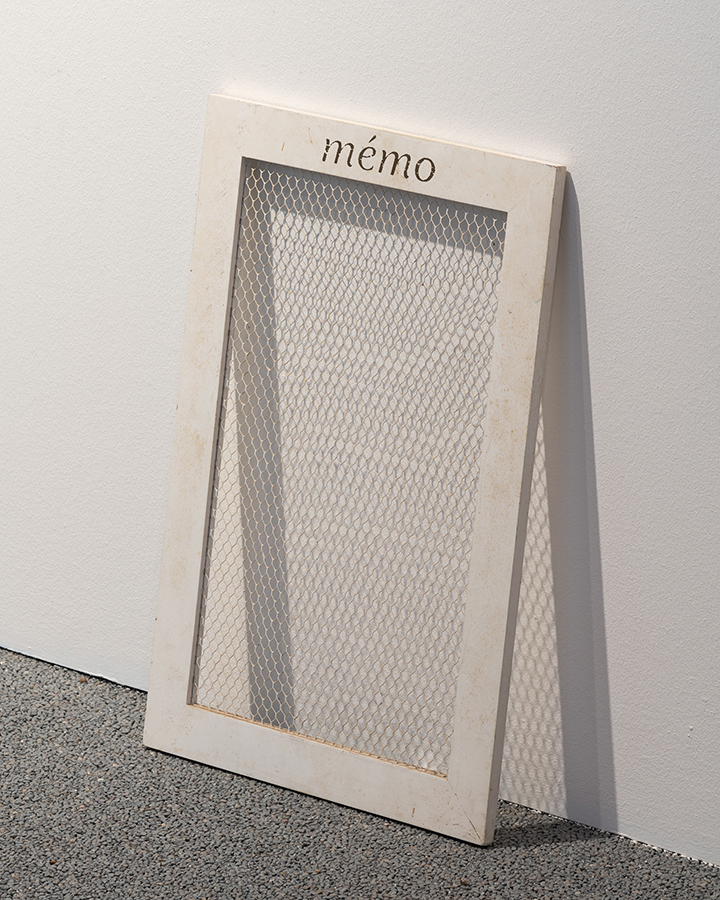
NOTES, 2019 (close up). Acrylics on porous wood fiber plate, order summery for Chinese dress mannequins, acrylics on plastic bag, Laura Ashley sewing pattern, lace, postcard, c-print on printer paper of family photos (my sister and the first set of clothes I sewed my self, and one from the time when I moved temporarily to my moms place and brought so many clothes and put them in her attic without asking). Photo: David Stjernholm.
-
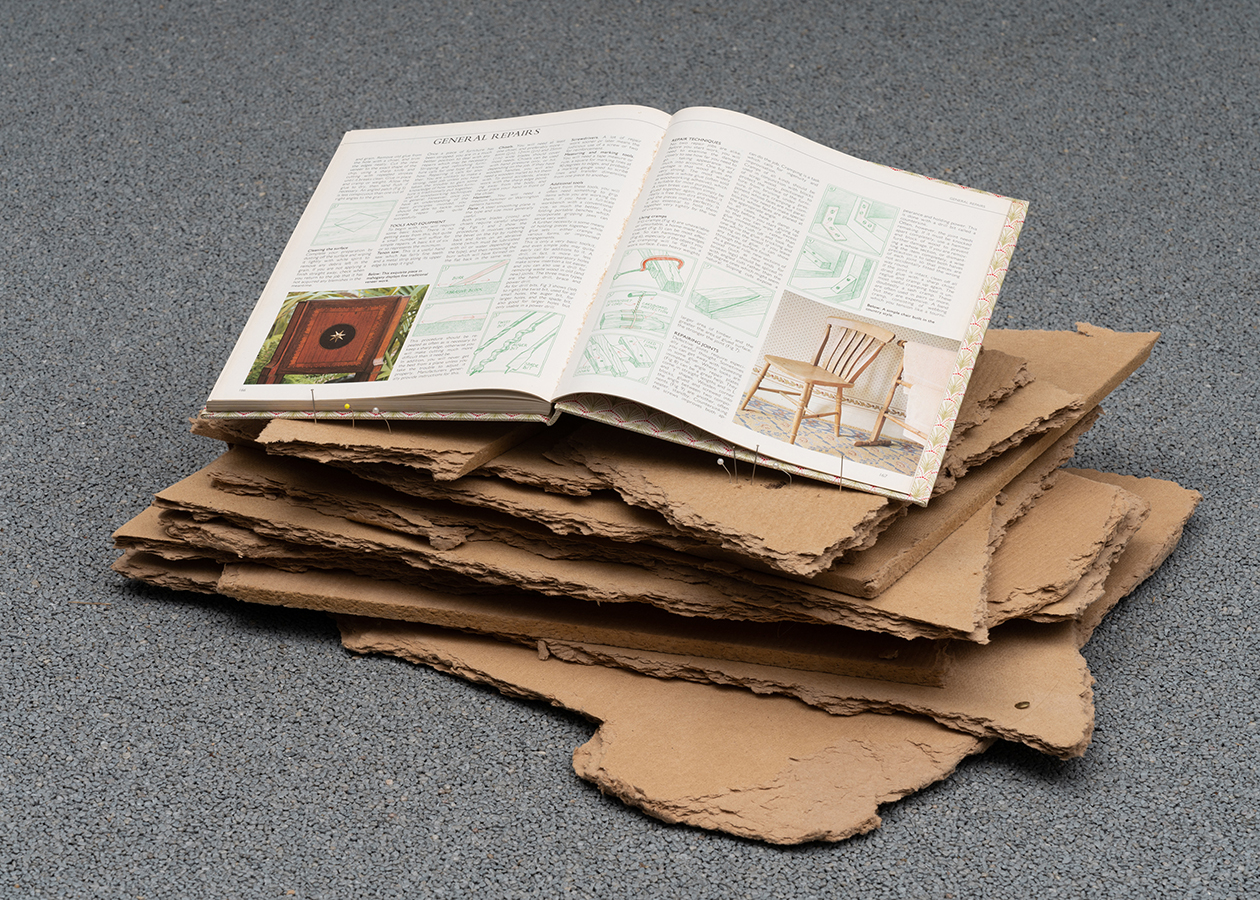
THE WORLD OF LAURA ASHLEY, 2019 Bee from window, Laura Ashley bramley logo broche in silver with box, montre in low iron glass, Charyn Jones (ed.), Laura Ashley’s complete guide to home decorating, Widenfeld & Nicolson 1989, porous wood fiber plate, Laura Ashley post order catalogue fall/winther 1985, Laura Ashley magazine, spring 1994, test print of MODEST FASHION etching, 2017, Anne Sebba, Laura Ashley : A life by design, Widenfeld & Nicolson 1990, one Laura Ashley No. 1 Eau de parfum still in box and one used, Elizabeth H. Wildhide, Laura Ashley : Windows, Widenfeld & Nicolson 1988, montres in low iron glass, Laura Ashley Home decoration post order catalogue 1987, Jane Tozer & Sarah Lev- itt, Fabric of society: A century of people and their clothes 1770-1870, Laura Ashley Publication 1983, rye straw bales (Morten Korch-type) lended by farmer in Husby, Elizabeth Dickson, Margaret Colvin, Dorothea Hall & Peter Collenette, The Laura Ashley book of Home decorating (revised edition), Treasure Press 1987, pins. Photo: David Stjernholm.
-
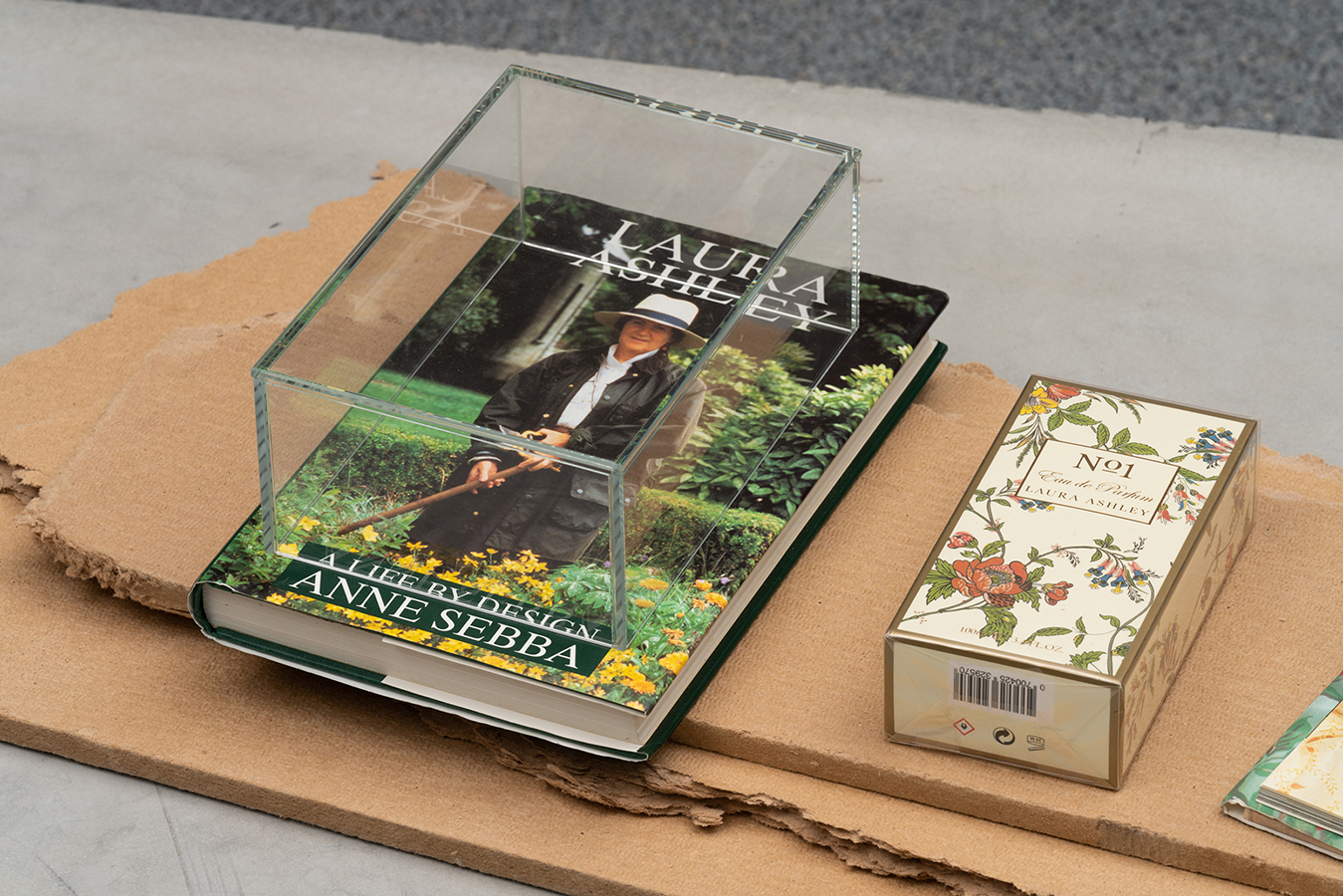
THE WORLD OF LAURA ASHLEY, 2019 Bee from window, Laura Ashley bramley logo broche in silver with box, montre in low iron glass, Charyn Jones (ed.), Laura Ashley’s complete guide to home decorating, Widenfeld & Nicolson 1989, porous wood fiber plate, Laura Ashley post order catalogue fall/winther 1985, Laura Ashley magazine, spring 1994, test print of MODEST FASHION etching, 2017, Anne Sebba, Laura Ashley : A life by design, Widenfeld & Nicolson 1990, one Laura Ashley No. 1 Eau de parfum still in box and one used, Elizabeth H. Wildhide, Laura Ashley : Windows, Widenfeld & Nicolson 1988, montres in low iron glass, Laura Ashley Home decoration post order catalogue 1987, Jane Tozer & Sarah Lev- itt, Fabric of society: A century of people and their clothes 1770-1870, Laura Ashley Publication 1983, rye straw bales (Morten Korch-type) lended by farmer in Husby, Elizabeth Dickson, Margaret Colvin, Dorothea Hall & Peter Collenette, The Laura Ashley book of Home decorating (revised edition), Treasure Press 1987, pins. Photo: David Stjernholm.
-
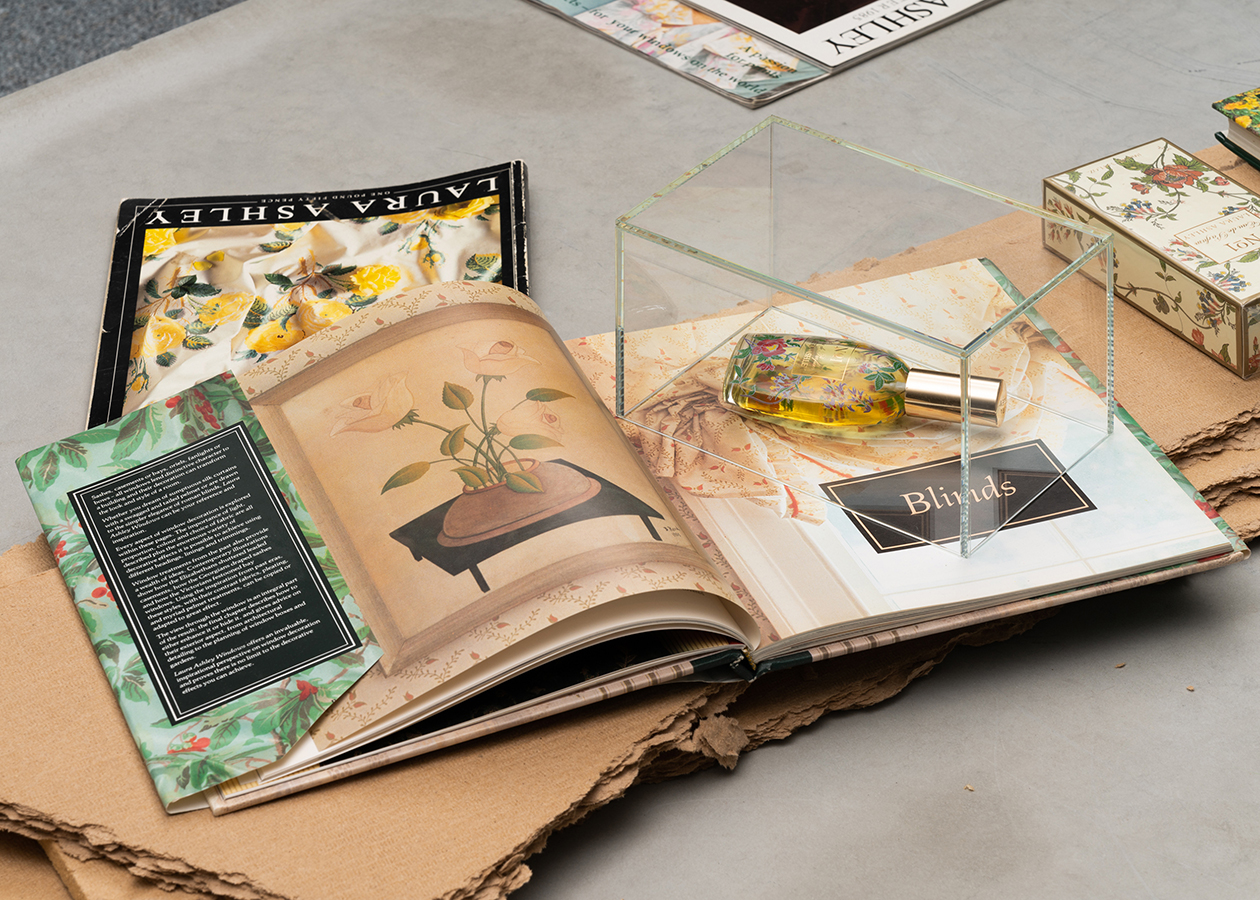
THE WORLD OF LAURA ASHLEY, 2019 Bee from window, Laura Ashley bramley logo broche in silver with box, montre in low iron glass, Charyn Jones (ed.), Laura Ashley’s complete guide to home decorating, Widenfeld & Nicolson 1989, porous wood fiber plate, Laura Ashley post order catalogue fall/winther 1985, Laura Ashley magazine, spring 1994, test print of MODEST FASHION etching, 2017, Anne Sebba, Laura Ashley : A life by design, Widenfeld & Nicolson 1990, one Laura Ashley No. 1 Eau de parfum still in box and one used, Elizabeth H. Wildhide, Laura Ashley : Windows, Widenfeld & Nicolson 1988, montres in low iron glass, Laura Ashley Home decoration post order catalogue 1987, Jane Tozer & Sarah Lev- itt, Fabric of society: A century of people and their clothes 1770-1870, Laura Ashley Publication 1983, rye straw bales (Morten Korch-type) lended by farmer in Husby, Elizabeth Dickson, Margaret Colvin, Dorothea Hall & Peter Collenette, The Laura Ashley book of Home decorating (revised edition), Treasure Press 1987, pins. Photo: David Stjernholm.
-
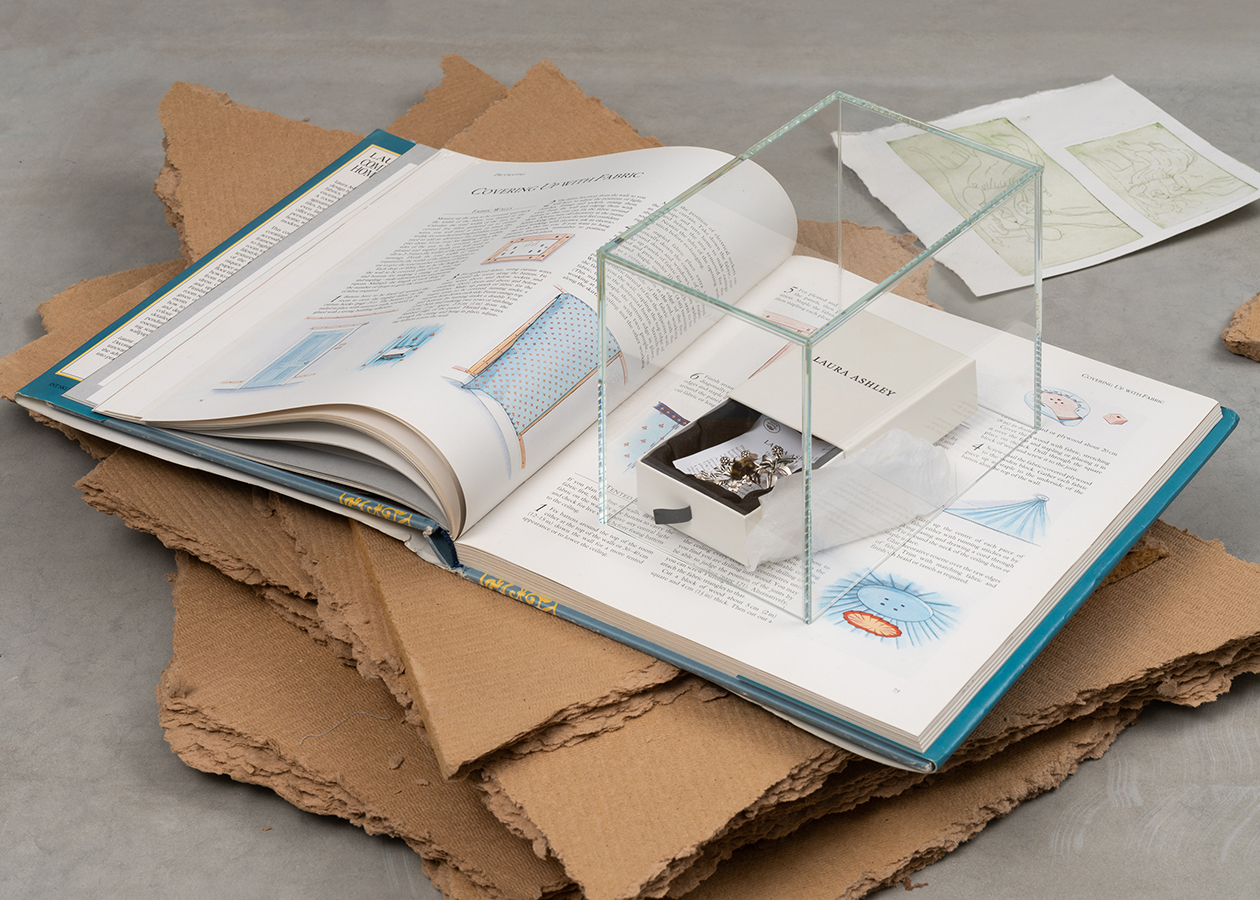
THE WORLD OF LAURA ASHLEY, 2019 Bee from window, Laura Ashley bramley logo broche in silver with box, montre in low iron glass, Charyn Jones (ed.), Laura Ashley’s complete guide to home decorating, Widenfeld & Nicolson 1989, porous wood fiber plate, Laura Ashley post order catalogue fall/winther 1985, Laura Ashley magazine, spring 1994, test print of MODEST FASHION etching, 2017, Anne Sebba, Laura Ashley : A life by design, Widenfeld & Nicolson 1990, one Laura Ashley No. 1 Eau de parfum still in box and one used, Elizabeth H. Wildhide, Laura Ashley : Windows, Widenfeld & Nicolson 1988, montres in low iron glass, Laura Ashley Home decoration post order catalogue 1987, Jane Tozer & Sarah Lev- itt, Fabric of society: A century of people and their clothes 1770-1870, Laura Ashley Publication 1983, rye straw bales (Morten Korch-type) lended by farmer in Husby, Elizabeth Dickson, Margaret Colvin, Dorothea Hall & Peter Collenette, The Laura Ashley book of Home decorating (revised edition), Treasure Press 1987, pins. Photo: David Stjernholm.
-
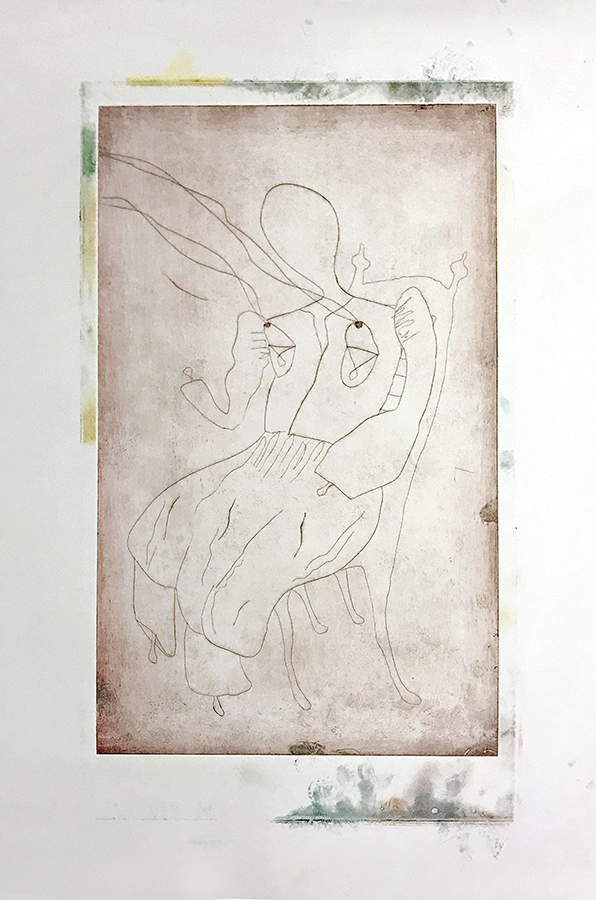
MODEST FASHION, 2018/19 (close up). Etchings with pencil drawing here and there, various paper types.
-
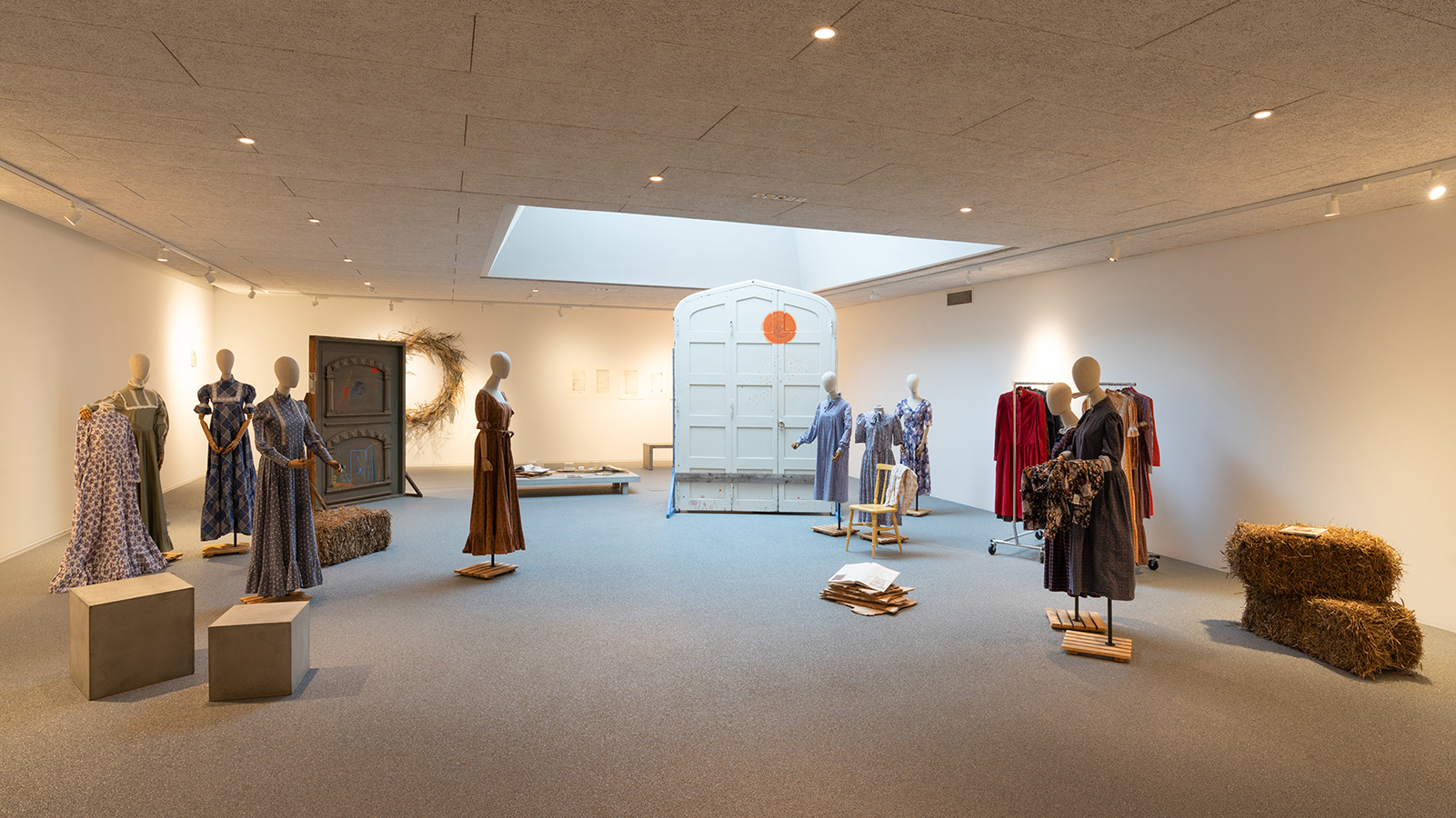
MY LAURA ASHLEY DRESSES, 2012-19. My collection of 1970s and 80s Laura Ashley dresses, presented on Chinese dress mannequins with linen look and wooden arms and supports. Photo: David Stjernholm.
-
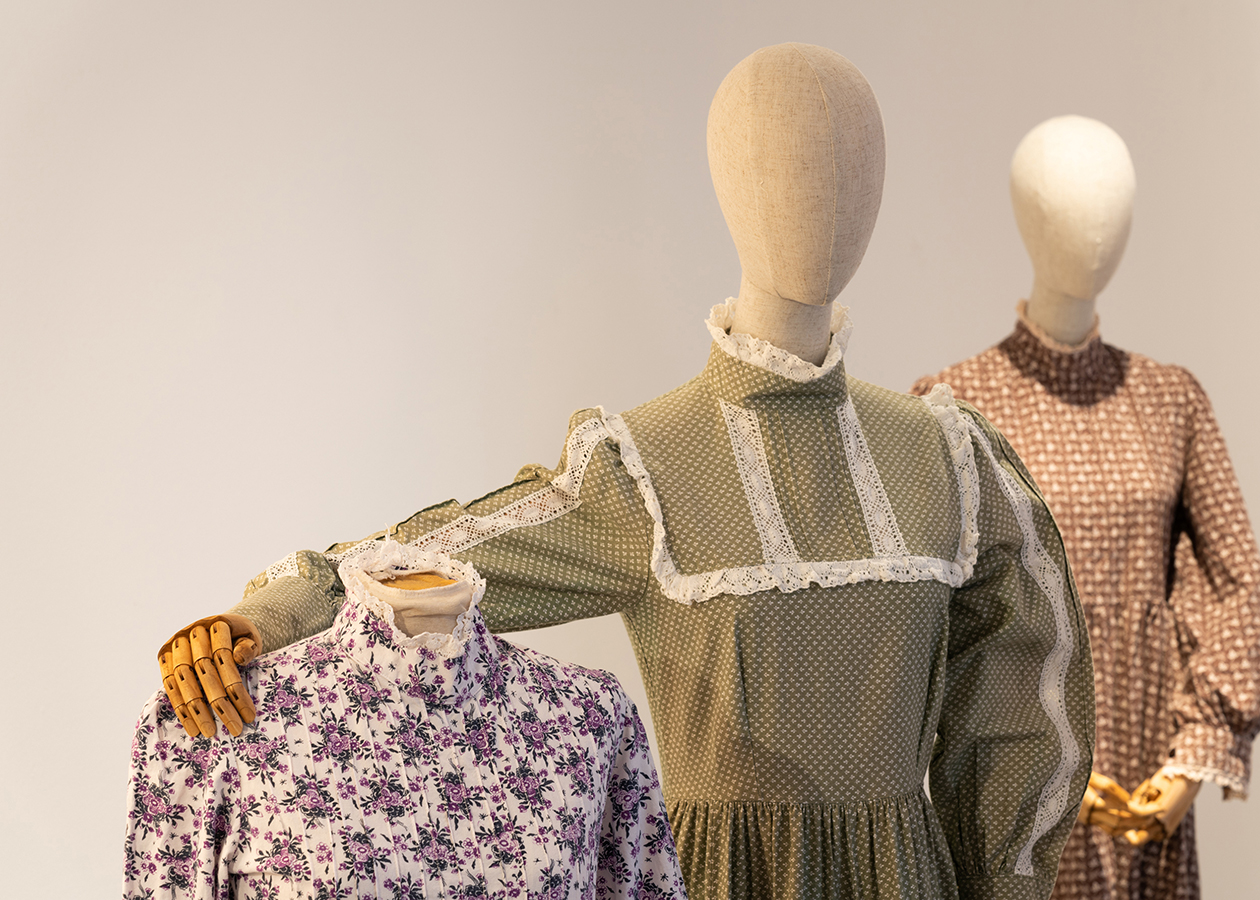
MY LAURA ASHLEY DRESSES, 2012-19. My collection of 1970s and 80s Laura Ashley dresses, presented on Chinese dress mannequins with linen look and wooden arms and supports. Photo: David Stjernholm.
Solo exhibition @ VK Samtidskunst at Vestjyllands Kunstpavillon, Videbæk, November 23 – December 29, 2019.
VK Samtidskunst at Vestjyllands Kunstpavillon is proud to present the solo show MY LAURA ASHLEY DRESSES by Hannah Heilmann. The exhibition circles around the artist’s love for and preoccupation with the English fashion brand Laura Ashley, and the boutique as a performative space. Arranging a display of Laura Ashley dresses and other ephemera with her own painterly work, Heilmann arrives at a setting looking halfway like a set design and a trade fair exhibition stand, channelling ideas around function, romance, luxury and modesty seen through the blurred lens of stylistic periods. If this brand analysis of the Laura Ashley look becomes a lens to look at fashion as consumer culture and desire driven economy whose sustainability is difficult to defend, then concurrently, the exhibition evokes notions of how fashion as a pop cultural language can be a modus for processing emotions around the crises that characterize our time. A daydream about guilt, melancholy, bewilderment and hope.
Make no mistake, this exhibition is about death and capitalism, and about the mild case of shopaholism that I share with so many. But it is also about my collection of Laura Ashley dresses.
My work with Laura Ashley starts in 2012, when I find myself in Leeds, working as a research assistant for an English art historian. In a thrift store I happen upon a light blue, floral eighties cotton dress, with a pleated skirt, it has a belt too; the top resembles a dress shirt. Without quite knowing why, I attach great meaning to the fact that it is a Laura Ashley dress. I remember showing the dress to the professor I work for, to whom it’s aura isn’t quite so obvious – he isn’t familiar with Laura Ashley. But I am, and that’s when I realize that the brand Laura Ashley holds a place in my understanding of a collective European memory.
In the years that follow it becomes more and more apparent, that clothes play an essential role in my artistic work. Not just as costumes or props, but also as a type of object that behaves in certain ways, connecting the private body with an extensive net of cultural capital and consumer economies. Clothing can act as an image, then a skin, then a commodity, a mystery, a tool, and a language.
In 2016 I’m on maternity leave, restless and tired. While the little one is sleeping I find myself buying 1970’sand -80s Laura Ashley dresses online. When the dresses arrive I try them on— of course I do, and most of the time I also take them of again. Part of me feels these purchases are work. My shopping is work. A guilty ghostly labour made in a time of ecological crisis, acting against my better judgment every day, I have been trained so well. I become an expert in the market for Laura Ashley dresses, how to date the items based on silhouette and print, their changing logo designs and place of production. The older and better dresses are from Carno in Wales; on the slightly later ones it just says Great Britain. In the mid-80s the production becomes a lot less local, and if the dress is made in Hungary or China, the dress is less desirable, that’s what the market for Laura Ashley dresses on eBay tells me. Incidentally, it is also in the mid-1980s that the Laura Ashley Company becomes publicly listed at about the same time that Laura Ashley falls down a flight of stairs and dies.
The Laura Ashley brand and business model is a Christian housewife-design-success from a time when more flamboyant forms of self-expression were all the rage; intersecting at a very sore point with consumer culture revealing the fashionable mess we have been in ever since. The modest bohemian-look, which the Laura Ashley brand came to represent in the 1970’s, is today a classic. Laura Ashley dress designs are often described as neo-Victorian and neo-Edwardian, but in fact they express a much fluffier fantasy about the 18th century, the pseudo Middle Ages and faux Empire joining to create a loose idea of pastoral past. Class and history and countryside and city and revolution and conservatism whirling around those dresses. Milkmaid-as-princess? University scholar with time for baking bread. Laura Ashley often reminded her employees: “Remember, we’re in the camouflage business.
Unravelling the designs historically they do not just point to idyllic countryside, but to the history of postcolonial economy and industrialization, not least taking the history of the printed cotton-calico fabric into consideration, how it came to Europe from Calicut in Kerala, India, to stir up the wardrobes of the meaner classes and set the European clothing fabricants in enough panic to have it banned until they mastered competing techniques. Westerner’s ability, and sense of right, to shop and trade without considering the context seems to be insistently consistent. If you fast forward you end up with me, the luxury-bohemian in the competition state, and the hint of religious puritan affect of my everyday climate-anxiety. Standing here shouting to the 18th century dream of the 1970’s: You see the downfall so clearly, turn around, you can change the future!”
The exhibition MY LAURA ASHLEY DRESSES is the 4th of 8 exhibitions curated by Anna Margrethe Pedersen as a part of the project VK SAMTIDSKUNST.